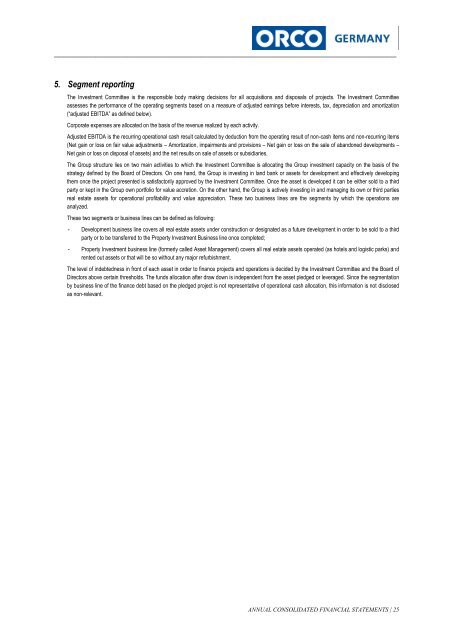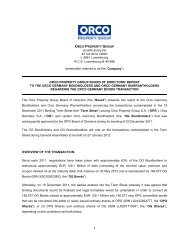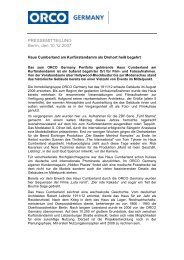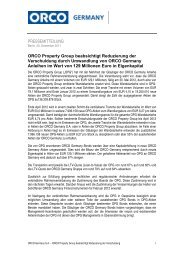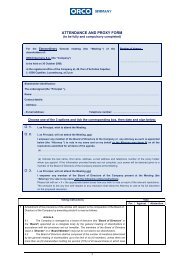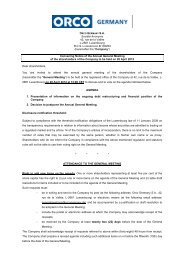Annual Report 2012 - ORCO Germany
Annual Report 2012 - ORCO Germany
Annual Report 2012 - ORCO Germany
Create successful ePaper yourself
Turn your PDF publications into a flip-book with our unique Google optimized e-Paper software.
___________________________________________________________________________<br />
5. Segment reporting<br />
The Investment Committee is the responsible body making decisions for all acquisitions and disposals of projects. The Investment Committee<br />
assesses the performance of the operating segments based on a measure of adjusted earnings before interests, tax, depreciation and amortization<br />
(“adjusted EBITDA” as defined below).<br />
Corporate expenses are allocated on the basis of the revenue realized by each activity.<br />
Adjusted EBITDA is the recurring operational cash result calculated by deduction from the operating result of non-cash items and non-recurring items<br />
(Net gain or loss on fair value adjustments – Amortization, impairments and provisions – Net gain or loss on the sale of abandoned developments –<br />
Net gain or loss on disposal of assets) and the net results on sale of assets or subsidiaries.<br />
The Group structure lies on two main activities to which the Investment Committee is allocating the Group investment capacity on the basis of the<br />
strategy defined by the Board of Directors. On one hand, the Group is investing in land bank or assets for development and effectively developing<br />
them once the project presented is satisfactorily approved by the Investment Committee. Once the asset is developed it can be either sold to a third<br />
party or kept in the Group own portfolio for value accretion. On the other hand, the Group is actively investing in and managing its own or third parties<br />
real estate assets for operational profitability and value appreciation. These two business lines are the segments by which the operations are<br />
analyzed.<br />
These two segments or business lines can be defined as following:<br />
- Development business line covers all real estate assets under construction or designated as a future development in order to be sold to a third<br />
party or to be transferred to the Property Investment Business line once completed;<br />
- Property Investment business line (formerly called Asset Management) covers all real estate assets operated (as hotels and logistic parks) and<br />
rented out assets or that will be so without any major refurbishment.<br />
The level of indebtedness in front of each asset in order to finance projects and operations is decided by the Investment Committee and the Board of<br />
Directors above certain thresholds. The funds allocation after draw down is independent from the asset pledged or leveraged. Since the segmentation<br />
by business line of the finance debt based on the pledged project is not representative of operational cash allocation, this information is not disclosed<br />
as non-relevant.<br />
ANNUAL CONSOLIDATED FINANCIAL STATEMENTS | 25


